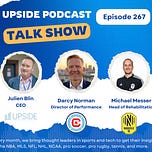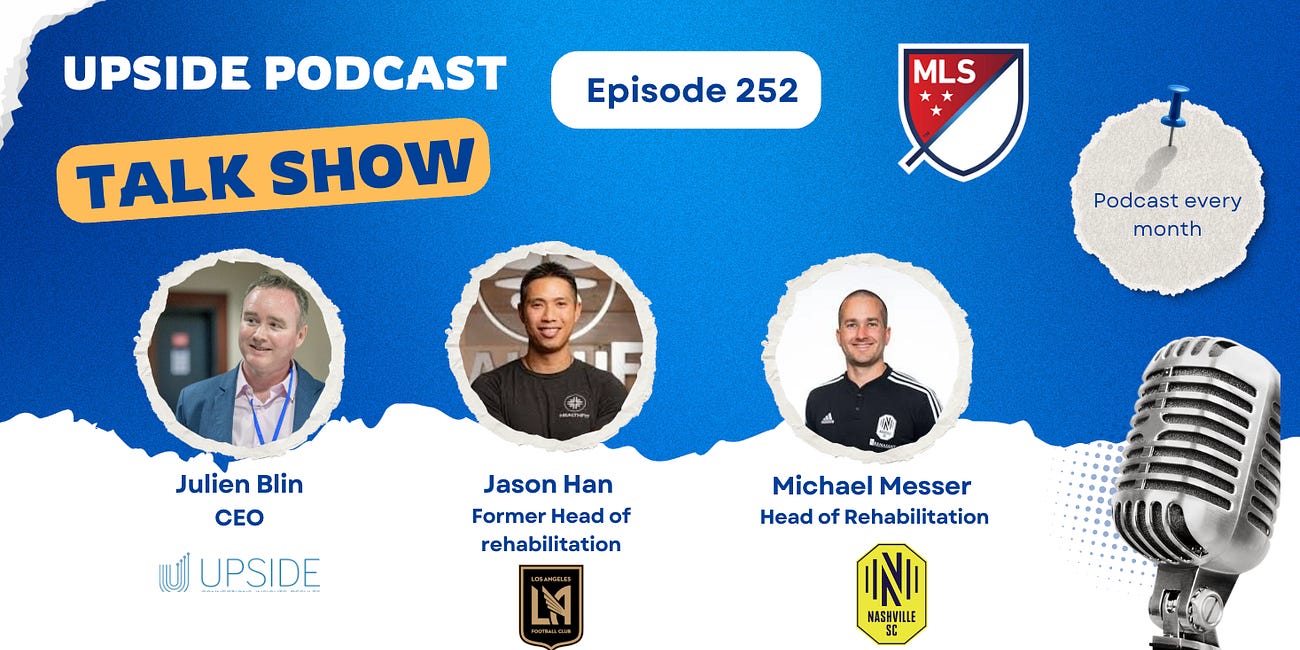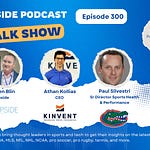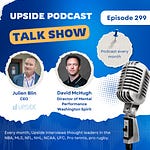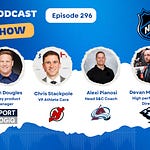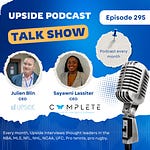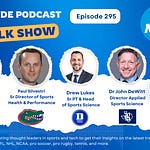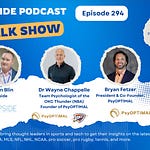This week we have the honor to interview again a group of MLS sports performance executives to talk about the latest trends in the world of sports performance and rehabilitation.
Michael Messer, the head of rehabilitation at Nashville SC (MLS).
Darcy Norman, the Director of Performance at Chicago Fire FC (MLS).
Karam Al-Hamdani, the Director of Sports Medicine and Head Athletic Trainer at the CF Montreal (MLS).
You can watch the video interview below by clicking on the Youtube link. You can also listen to the audio interview by clicking on the link at the top of the page:
Here are some of the best quotes of our conversation with Michael, Darcy, and Karam:
Q1. What’s one innovation or methodology in global football that MLS teams should adopt more aggressively?
Darcy Norman:
“The globalization of the game has really flattened the playing field—ideas, tech, and methodologies are traveling fast. But what concerns me is how we interpret and apply research. There’s this trend now where we latch onto headlines instead of engaging critically with the full body of work. For example, the idea that ACL recovery should take exactly nine months becomes gospel, even if the underlying study had a really small sample size or narrow scope. We end up chasing metrics or timelines that aren’t rooted in strong evidence. I think MLS teams—and really all of us—need to get better at being skeptical and intellectually curious, not just grabbing onto flashy data points. Let’s actually read the research, understand the methodology, and apply it within context. That’s something I saw more of in Europe, especially at Bayern and the German national team. The best environments are driven by informed decision-making, not just confirmation bias.”
Karam Al-Hamdani:
“One thing we’re still struggling with in North America is the rigidity around hiring international staff. You might have someone with incredible experience—say a world-class physio from Ligue 1 or the Bundesliga—but bringing them in is a massive legal and credentialing headache. Europe just doesn’t have that same bureaucracy. Their systems are more fluid, and that allows for cross-pollination of people, not just ideas. If MLS wants to grow and really become globally competitive, we have to be more open—not just to importing knowledge but to letting talent in the door. That’s how new philosophies, methodologies, and even rehab protocols spread and improve a team’s capacity to evolve.”
Michael Messer:
“One of the more interesting things I saw during my time in Europe was how clubs brought in PhD students or researchers from nearby universities and embedded them into their performance teams. These weren’t interns—they were conducting real-time research that was immediately applicable to training or recovery processes. There’s this fluid exchange between science and sport, and the players and staff both benefit from it. That kind of embedded academic collaboration is something I think MLS could really benefit from. Right now, we tend to see that more at the NCAA level in the U.S., but it’s rare at the pro level. If we want to stay ahead or at least keep pace, that’s an innovation we should push toward—bringing science into the locker room, not just referencing it from the outside.”
Q2. What recovery modalities have become non-negotiable for your squad this season, and what’s fallen out of favor?
Karam Al-Hamdani:
“Recovery days in Montréal have evolved into comprehensive, full-service experiences. We’re not just doing a quick flush or static stretch anymore. We’ve structured the day around delayed arrival times to allow more sleep, followed by a progression of yoga, Pilates, mobility sessions, and hands-on medical assessments. From there, players move into their individualized recovery blocks—cold immersion, pneumatic compression, and even upper body lifts to stimulate a hormonal recovery response. We’ve partnered with a local wellness provider for optional cryotherapy, red light therapy, and infrared sauna access. These modalities are no longer just nice to have—they’re embedded into our rhythm. The players understand the 'why' behind them, and that’s what makes them stick. What’s fallen out of favor for us are the gimmicky, unvalidated tools—if there’s no evidence and no consistent feedback from the athletes, we phase it out.”
Darcy Norman:
“I use a pyramid model to structure recovery planning. At the base: you need solid fundamentals—sleep, nutrition, and planning. Those are non-negotiable. Then we build in tools like compression, hydrotherapy, soft tissue work, lifting, and parasympathetic recovery methods. Once those are dialed in, we consider the '2-percenters'—things like infrared beds, hyperbarics, and advanced wearables. We’ve also brought in Fly Kit, a nutraceutical solution designed to help athletes regulate light exposure and circadian rhythms during travel. That’s been a game-changer for international trips and jet lag. But we’re always careful not to throw tech at problems without context. The real question is: what fills this player’s bucket? If cold tubs don’t work for them but manual therapy does—we adjust. Our job is to recharge each player’s battery in the most efficient and individualized way possible.”
One tool we’re testing is the Nix Biosensor, which tracks sweat rate and electrolyte loss in real time. That’s helped us fine-tune hydration protocols for different players. But ultimately, recovery isn’t a one-size-fits-all model. It’s about consistency and getting player buy-in, not loading up the room with gadgets and assuming they’ll use them.”
Michael Messer:
“I think Darcy summed it up really well with the pyramid analogy. What I’ll add is that the base of the pyramid is where the most science exists—it’s the most proven to be effective. Our approach has been very centered around that foundation. This year, we've been more intentional about what the athletes are putting into their bodies—whether that’s hydration or food—on specific days of the week. That’s come from the staff growing and collaborating more closely with our coaching staff and director of high performance.
We’ve also adjusted training times depending on where we are in the week, which has helped. More recently, the big issue has been the heat. So we’ve been exploring any cooling strategies we can implement to reduce the negative effects and help the guys recover more effectively. We’ve spent a lot of this season doubling down on the foundation—sleep, hydration, and nutrition. With the heat being so brutal this year, we’ve had to customize our training and recovery windows to ensure players aren’t depleted.
Q3. Are you piloting any AI-driven tools, and how are they being received?
Darcy Norman:
“We’re currently testing a few different tools—vMotion, B1 Sports, and other AI-enhanced movement screening platforms. I also use AI personally to summarize workflows, clean up documentation, and improve efficiency. The catch is: if the system doesn’t fit seamlessly into existing processes, or if it demands a ton of time to validate the outputs, it’s just not practical. You also have to be careful about what data you feed into the system. AI doesn’t remove the need for critical thinking. If you input bad data, you’ll get bad recommendations, no matter how smart the algorithm is. So I still validate everything manually. Until we reach the point where the tech truly understands context, we have to act as the filter between raw data and decision-making.”
Karam Al-Hamdani:
“At the moment, I’d say AI hasn’t made a massive impact on how we work. Sure, there are a few tools we’ve looked at for administrative organization or wellness flagging, but I haven’t seen anything yet that gives us a decisive edge on the pitch. In a game of such fine margins, we need tools that elevate decision-making, not just data collection. Right now, a lot of what’s out there still feels like AI for the sake of AI. I’m not opposed to it—I just don’t think we’ve reached the point where it’s essential yet. Ask me again in five years and I might give you a completely different answer.”
Michael Messer:
“We’re using some AI-adjacent tech, particularly through our Valor system, which provides movement analysis and some automated load insights. It’s useful, but I’ll admit I still like to look at the raw numbers myself. Part of that is trust—if I don’t understand how the model is making its decisions, I hesitate to rely on it. I’ve joked that I need an ‘AI 101 for Coaches’ class, because I’m just not there yet. We’re still in the early adopter phase, and I’m very cautious about letting AI guide decisions without deep understanding. I’d rather have something simple and trustworthy than something that’s cutting-edge but unexplainable.”
Q4. With Apple TV and global exposure increasing, has there been more pressure to optimize performance for primetime matches or international audiences?
Darcy Norman:
“Honestly, compared to my experience in Europe, the schedule in MLS is still quite manageable. At Bayern, we were playing league matches, domestic cups, Champions League, and players had national team duty layered on top. That’s 50 to 60 matches a year—plus travel. In MLS, it’s 34 games in the regular season and the occasional cup. Most of our matches are at 7:30 p.m. local, which gives us a rhythm and allows for better planning. Where the stress hits is during FIFA windows. You might lose 5–6 players to international duty and still have to compete in the league. That’s where we feel the strain—not from broadcast demands, but from roster gaps and condensed fixtures.”
Karam Al-Hamdani:
“I wouldn’t say Apple TV or international exposure directly affects how we operate medically. The pressure is internal. It comes from wanting to do right by the players and the team. For me, it’s about ensuring a player is in the best possible condition to perform—regardless of whether it’s a primetime game or not. If a guy is 90% ready, and we have a national TV game, I’ll still advocate for him to wait if the risk is high. My north star is always the player’s long-term health and performance. External exposure doesn’t change that for me—it actually reinforces the need to be even more thorough.”
Michael Messer:
“I echo what Darcy and Karam said. No one’s knocking down our door saying, ‘You have to perform better because the game’s on Apple TV.’ That said, context matters. If we’re missing two starters because of international call-ups and another guy is coming off injury, we have to navigate those conversations carefully. Coaches want to know: can this guy go? Should he go 45 minutes or 90? The timing of the match—who’s watching, what’s at stake—absolutely influences those discussions, even if indirectly. And yeah, I might take a few extra minutes on match day to make sure I don’t look like a mess on the bench now that the cameras are everywhere!”
You may also like:
🔥Upside Chat with Mike Messer (Nashville SC / MLS), Jason Han (Ex LAFC / MLS) on Biohacking, Shiny Tech Objects, The MLS Evolution, and PSG's Champions League Win
This week we have the honor to interview again a group of sports performance executives to talk about the latest trends in the world of sports performance and rehabilitation.
🔥Upside NHL Group Chat with Alexi Pianosi (Colorado Avalanche), Chris Stackpole (NJ Devils), Adam Douglas (Penguins)
This week we have the honor to interview a group of NHL sports performance executives to talk about the latest trends in the world of sports performance, load management, sleep/recovery management, rehabilitation and data & wearable tech integration, and mental performance in the NHL.
🔥Upside Chat with Chris Chase (Memphis Grizzlies/NBA), Dr Marco Nunez (ex LA Lakers/NBA), Dr Andy Barr (Quantum Performance), Derek Millender (Cleveland Cavaliers /NBA).
This week we have the honor to interview again a group of NBA sports performance executives:

